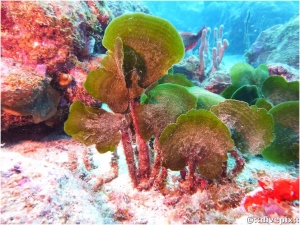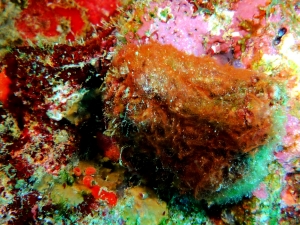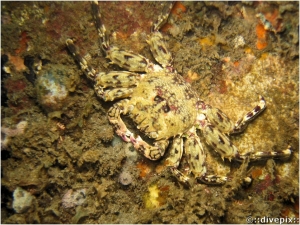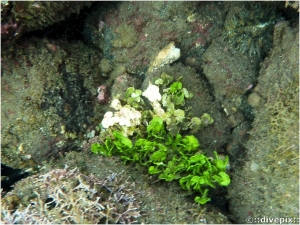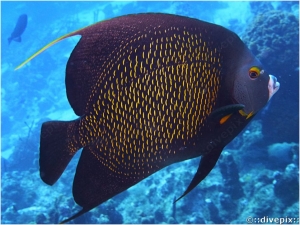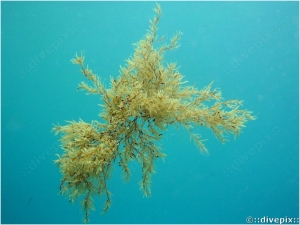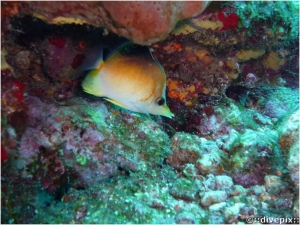




Daniel H. Biass
White Mermaid's Wine Glass
| Aspect: | At first sight looks like pale green to white monochrome daisy, but is in fact composed of a radially fluted disc on a thin stalk. |
| Population: | Not widespread. |
| Notable feature: | Very fragile. Solitary and therefore difficult to spot. |
| Environment: | Grows in sheltered areas, amidst other protective algae or weeds. |
| Behaviour: | . |
Who are we?
Who are we?
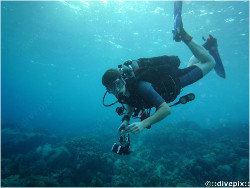
Saucer Blade Alga
| Aspect: | Green leaves (blades) shaped like small, thin ping-pong rackets on variable length brownish stems. Blade surface looks like felt. |
| Population: | Common. |
| Notable feature: | Tend to grow in line because the stems are attached to a common root running under the sand. |
| Environment: | Shallow sandy bottoms. |
| Behaviour: | . |
Home
Welcome to ::divepix::
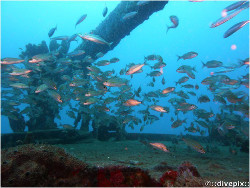
The site is bilingual English and French, but wherever possible species are also being given their local Creole designation.
As it turned out
Illustrating a decade of regular diving on the west coast and south of Basse-Terre (namely Saintes and Sec-Pâté), these photos turned out to have a survey value with the authors’ diving logbook notes pointing to demographic changes, which more often than not are cyclical.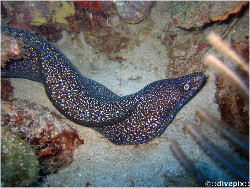
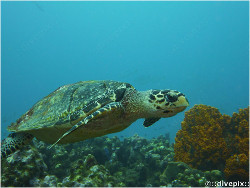
Swiss Cheese Alga
| Aspect: | Brown entanglement of loosely intertwined fibres reminiscent of a decaying rug. |
| Population: | Common. |
| Notable feature: | May sometimes be seen rolling on the sea bed, pushed by currents. |
| Environment: | Relatively shallow waters. |
| Behaviour: | . |
Tidal Spray Crab
| Aspect: | Overall light brown/yelowish appearance, closer look reveal a grey-yellow carapace peppered with small dark spots, centre has mottled red and brown areas. Legs are the same colour with larger brown stains, while their outer segments are brown banded. Eyes are yellow-pale green and close to the carapace. |
| Population: | Common. |
| Notable feature: | Deep cleavage in the middle of the "forehead" area of the carapace. Tip of the short red claws are white. |
| Environment: | Tidal waters. |
| Behaviour: | Weary. |
Watercress Alga
| Aspect: | Small green, irregularly rounded leaves densely attached to short branching stems. |
| Population: | Common. |
| Notable feature: | . |
| Environment: | Usually found in shallow, waters, between rocks. |
| Behaviour: | . |
French Angelfish
| Aspect: | Adult features white-grey mouth, blue head with yellow eye-brows, followed by dark body with yellow-edged scales. Young individuals boast overall dark body with three heavy yellow vertical bars that fade away at intermediate stage as grey snout and blue head develop more strongly. Even younger individuals have bright blue pectoral and anal fin tips. |
| Population: | Regularly abundant. |
| Notable feature: | Often live in pairs. |
| Environment: | Usually found at depths of between 20 and 40 metres, the latter particularly in or around wrecks. |
| Behaviour: | Will usually tolerate a diver's quiet presence, even totally ignoring his presence when a nearby turtle is busy shredding a sponge and throwing nourishing debris around. |
Sargassum Seaweed
| Aspect: | Ochre serrated leaves attached to a dark brown multiple-branch central stem. More usually seen floating on the surface of the sea, sometimes floating midwater on their slow ascension to the surface. |
| Population: | Normally not abundant in Guadeloupe, except in the mangrove areas. Invasive waves of such algae have however started to reach the islands, drifting northwards from the southern areas of the Caribbean. |
| Notable feature: | Each branch carry a number of light ochre berries that are in fact thin-skinned gas-filled bulbs that enable the plant to remain erect and thus facilitate photosythesis, but they also eventually causes it reach the surface. |
| Environment: | The plant actually grows under the sea surface. The recent outbreak of large floating mats in the Carribean is attributed to a combination of two main factors, namely the over-use of agricultural fertilisers in areas of Central and South American mainland promoting their growth, and a change of sea currents resulting from the climatic change. |
| Behaviour: | . |
Longsnout Butterflyfish
| Aspect: | Almost looks like a cartoon character with white lower body fading into a bright yellow upper body topped by almost dark dorsal fin. Tail and pectoral fins are transparent |
| Population: | Regularly abundant. |
| Notable feature: | Unrealistically long snout that earned it its "Pinokio" designation in local creole. |
| Environment: | Usually found in shallow, quiet waters |
| Behaviour: | Very shy, always turning around stones and boulders, difficult to photograph. |





